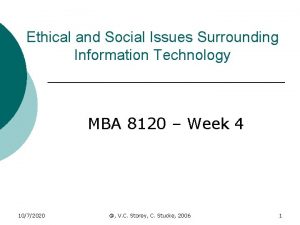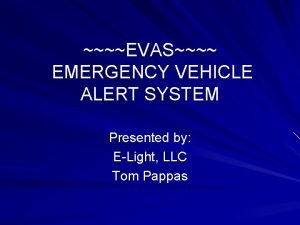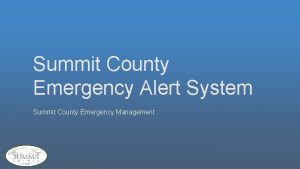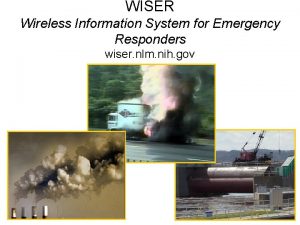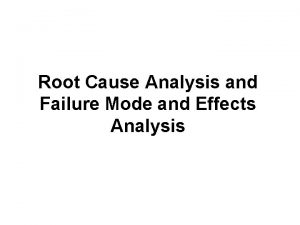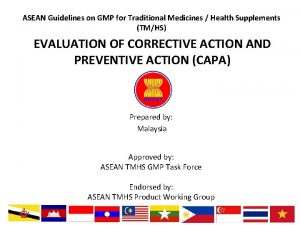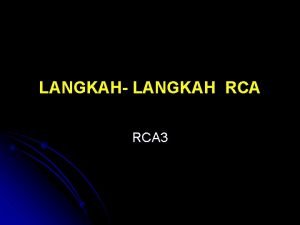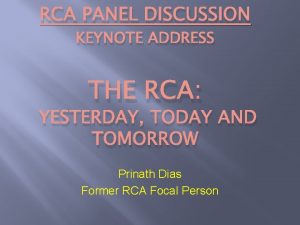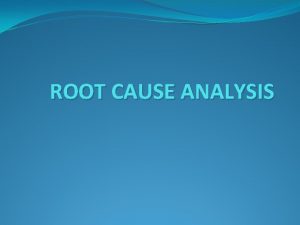RCA Issues Surrounding Wireless Emergency Alert Systems Art












- Slides: 12

RCA Issues Surrounding Wireless Emergency Alert Systems Art Prest For RCA October 24, 2005 1

RCA RCA: Rural Cellular Association • ~100 Tier III Wireless Carriers • Covering about 15 Million POPS • Operating in Some of the Most Rural Areas of the US • Focused on Needs of Rural Customers • Wireless Technologies: – Analog – TDMA – CDMA – GSM October 24, 2005 2

RCA Emergency Alert Service (EAS) • FCC August 2004 NPRM on Emergency Alert System & Congressional AHALERT Bill – Driven by terrorist threat & tsunami fear – Pushed by Senator Stevens (R-Alaska) • Alternatives being discussed: – SMS – Cell Broadcast – New Technologies October 24, 2005 3

RCA S 1753 Functions • will enable any Federal, State, tribal, or local government official with credentials issued by the National Alert Office under section 103 to alert the public to any imminent threat that presents a significant risk of injury or death to the public; • will be flexible enough in its application to permit narrowly targeted alerts in circumstances in which only a small geographic area is exposed or potentially exposed to the threat • will transmit alerts across the greatest possible variety of communications technologies, including digital and analog broadcasts, cable and satellite television, satellite and terrestrial radio, wireless communications, wireline communications, and the Internet to reach the largest portion of the affected population. October 24, 2005 4

RCA • RCA’s Comments & Message SMS Text Based EAS Issues: – Does not have capacity for ubiquitous EAS – Messages are not geographically specific – Message length to short (~160 characters will lead to unintended consequences) • Cell Broadcast EAS Issues: – Standards exist, commercial products do not – Would require change out of handsets (all CDMA; some GSM) – Existing GSM Cell Broadcast technology reduces battery “talk time” – Interface from Cell Broadcast Center to BSC not standardized or developed – High Carrier Involvement: wireless carrier would have to parse EAS messages and distribute them to the appropriate cell sites as required – Message length limited (256 characters for CDMA & 93 for GSM) – High cost and no revenue potential by itself (message sent to all handsets & acknowledged by none) – ETSI reports that this is a barrier to deployment in Europe October 24, 2005 5

RCA Proposed Alternative • Integrate NOAA NWS Public Alert Radio Receiver Capability Into Cell Phone: – Backward compatible with existing EAS system – 97% of population of US, Puerto Rico, Virgin Islands, and Guam covered – Messages can be geographic specific using SAME codes • Specific Area Message Encoding uses a Six digit code based on FIPS (Federal Information Processing Standard) codes • Possible to define ~9, 000 specific geographic areas per State – Audio message length unlimited – Carrier is not responsible for disseminating EAS messages – Minimal impact on network October 24, 2005 6

RCA • RCA Proposed Alternative Development & Changes Required: – Develop and implement EAS radio chip sets into phones (other market potential for chipsets? ) – Develop standards to dynamically program SAME codes into phone as it moves through network – Change-out of handsets: • No forced replacement • Allow churn to drive replacement • Price to recover incremental cost • CEA survey indicated 65% of population surveyed were interested in owning a portable device having Public Alert Radio capability – Additional cell sites could be constructed at key/strategic locations at the behest & cost of government agencies October 24, 2005 7

RCA NOAA NWS All Hazards* Radio • Includes 7 channel NOAA weather radio • SAME Code Programmable – Up to 6 SAME codes – e. g. , 051013 VA Arlington County – ~9, 000 geographic areas per state possible • Size: 5. 48” x 3. 96” x 1. 4” 4. 59 oz • Three AA batteries last ~4 weeks October 24, 2005 * Public Alert 8

RCA NWS All Hazards Radio Demo October 24, 2005 9

RCA NOAA NWS Test Message Entire 39 Second 782 Character Audi Message This is a test of the NOAA radio warning device. During potentially dangerous weather situations, specially built weather radios will be automatically activated to warn of the impending hazards. Tests of these radios and the warning system will be conducted by the National Weather Service every Wednesday between 11 AM and Noon. Reception of this broadcast, and the warning alarm, will vary at any given location. This variability, normally more noticeable at greater distances from the transmitter will occur even though you are using a good quality receiver in perfectly good working order. To provide the most consistent warning service possible, the warning alarm will be activated only for warnings and selected watches affecting the listening area. 160 characters and spaces (typical CDMA or GSM SMS text message limit): This is a test of the NOAA radio warning device. During potentially dangerous weather situations, specially built weather radios will be automatically activated 93 characters and spaces (GSM Cell Broadcast text message limit): This is a test of the NOAA radio warning device. During potentially dangerous weather situati October 24, 2005 10

RCA Benefits of NOAA Public Alert Radio Proposal • Message length is unlimited because EAS messages are audio based and the message is essentially a government radio broadcast that is being received by a radio receiver integrated into a wireless phone • NOAA Public Alert radio broadcasts cover 97% of the population of the entire United States including Guam, Puerto Rico, and the Marianna Islands • The audio message is not being transmitted through the wireless network thus avoiding bandwidth limitations of wireless networks • Wireless carriers are not responsible for disseminating EAS messages • By using SAME codes, EAS messages can be delivered to very discrete geographic areas (almost 9, 000 geographic specific areas per state are possible). At the request of government entities, cell sites having discrete SAME codes could be built at critical state and federal government locations such as the Capitol, Pentagon, nuclear power plants, airports etc. • Unlike Cell Broadcast technology where there is a significant difference in what is available for GSM technology versus CDMA technology, such an approach is technologically neutral • According to a recent Consumer Electronics Association survey, 65% of the population surveyed are interested in owning portable Public Alert radio capability. It is believed that such interest would motivate subscribers to buy new handsets that include NOAA Public Alert radios October 24, 2005 11

RCA Issues for Consideration 1. Battery Life: what might the integration of NOAA All-Hazards radio technology have on battery life of the wireless phones? 2. Antenna Size: what size antenna will be required to receive the 162 MHz NOAA EAS radio broadcast? 3. Cost: how much will the integrated radio increase the cost of a wireless phone? 4. Could the integrated NOAA radio be designed to receive All-Hazards alerts using the Digital Emergency Alerts being broadcast over the Public Television digital channels in the FEMA pilot program? 5. How long will it take to introduce integrated NOAA All-Hazard wireless phones to market? 6. What about the deaf and hard of hearing? October 24, 2005 12
 Issues surrounding information privacy
Issues surrounding information privacy What ethical issues surrounding executive compensation
What ethical issues surrounding executive compensation Emergency vehicle alert system
Emergency vehicle alert system Summit county alerts
Summit county alerts What are wireless devices and the wireless revolution
What are wireless devices and the wireless revolution Wiser artinya
Wiser artinya Voluntary and involuntary health agencies
Voluntary and involuntary health agencies Rca and capa of medication error
Rca and capa of medication error Frederick feit
Frederick feit Rca dalları
Rca dalları Ikari right guide catheter
Ikari right guide catheter Rca and capa format
Rca and capa format Spider view cag
Spider view cag
